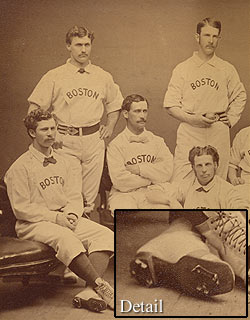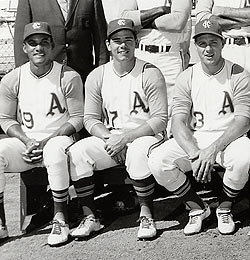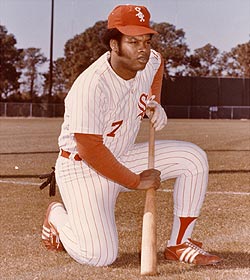 |
|
|
Shoes
|
|
|
|
Early Shoes and KangaroosLittle is known about the very earliest baseball shoes. Most likely they were identical to athletic shoes of the day: high-tops, with simple canvas uppers and no spikes. As canvas tended to break down where creases formed, baseball shoes of the 1870s incorporated portions made of leather. Spalding’s “Chicago Club Shoe” was their first foray into a combined leather-canvas upper, and the sporting goods company claimed that the shoe was the “same as used by the Chicago and other League clubs.” The first all-leather shoe made available by Spalding was the calf skin “League Club Shoe,” first offered in 1882 for $6 per pair. By the end of the decade, Spalding had introduced an all-Kangaroo leather shoe available for $7 per pair. Strong, soft, and remarkably durable, Kangaroo leather remained a popular material for baseball uppers throughout much of the 20th century. At left: Shoes as advertised in Spalding’s Base Ball Guide of 1883
|
|
|
Spikes and the LikeThough it is likely that no spikes were used on the earliest baseball shoes, by the late 1860s spikes similar to those found on modern golf shoes were used by top-flight players. The spikes were removable and a complete set cost $1.50. What are now recognized as the more traditional metal baseball cleats, the tri-cornered shoe plates worn under the toe and the heel, were first introduced in the 1870s. These steel-plate cleats were much less expensive (30 cents per pair when first advertised by Spalding) than the individual spikes and, according to the Spalding Base Ball Guide of 1880, “the majority of professional baseball players use these plates both on the heel and the toe.” The introduction of the shoe plate signaled the demise of individual spikes, but it was not until 1976 that the baseball rulebook explicitly outlawed spikes such as those found on golf and track shoes from the baseball field. At left: The Boston Red Stockings wearing shoe plates, 1874
|
|
|
Shoes in Hues of Reds, Whites and BluesBeginning with the introduction of the all-leather baseball shoe in the 1880s, baseball shoes remained black or dark brown through the mid-1960s. The Kansas City A’s broke this long standing tradition in 1967 when they introduced white shoes to their already revolutionary green and gold uniforms. Though club members were derided by opposing players for the new look, the A’s have worn white shoes ever since. Clubs began adopting shoes of other colors starting in the late 1960s, with solid red and solid blue being the favored hues. At left: Bert Campaneris, Ken Suarez and Mike Hershberger of the Kansas City Athletics wearing white shoes, 1967
|
|
|
The Strange Case of the Shoeshine ShamOn July 4, 1973, Texas Rangers left-handed pitcher Jim Kremmel made his big league debut. At one point during the game, Kremmel tossed a wild pitch with Chicago White Sox shortstop Eddie Leon at bat, but Leon claimed that the ball had actually nicked his shoe and therefore he was entitled to first base. Leon urged home plate umpire Larry Barnett to inspect the ball, claiming that a black smudge on its surface was actually shoe polish. Barnett agreed with Leon and awarded the batter first base. Similar cases of baseballs being smudged with shoe polish were nothing new, but Barnett overlooked one clue in regard to the Leon claim: the White Sox wore red shoes! At left: Carlos May of the Chicago White Sox donning red shoes, c. 1974
|
Cleats on Their FeetThe introduction of artificial turf in the mid-1960s had a significant effect on the game of baseball. Ground ball outs on grass were often base hits on turf, bad infield hops were a thing of the past, and improved drainage meant heavy rains only caused delays, not cancellations. The synthetic grass also led to a change in the baseball shoe. Many players abandoned metal cleats in favor of flat-bottomed shoes, and some even filed down their steel cleats. By the late 1970s, companies began manufacturing shoes specifically designed for the new surface. The soles were constructed with hundreds of small rubber bumps that provided excellent traction, yet didn’t catch on or harm the artificial surface. Baseball shoes with plastic cleats were introduced in the early 1980s. |
|
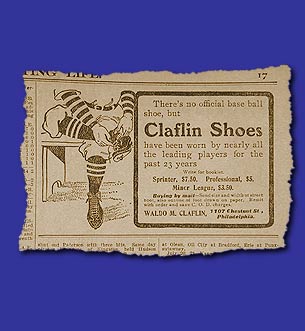 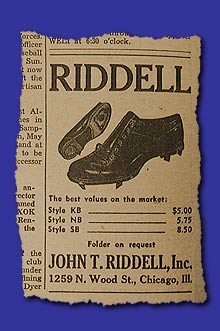 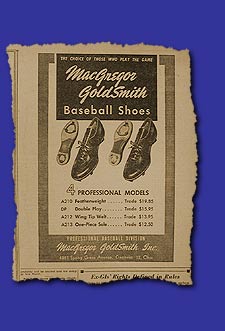
At left: Advertisement for Claflin baseball shoes from The Sporting
Life, 1906
|
|
|
Dressed to the Nines: A History of the Baseball Uniform |
|

